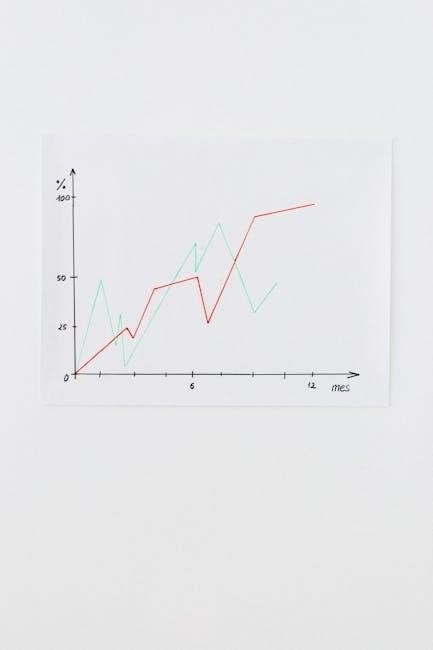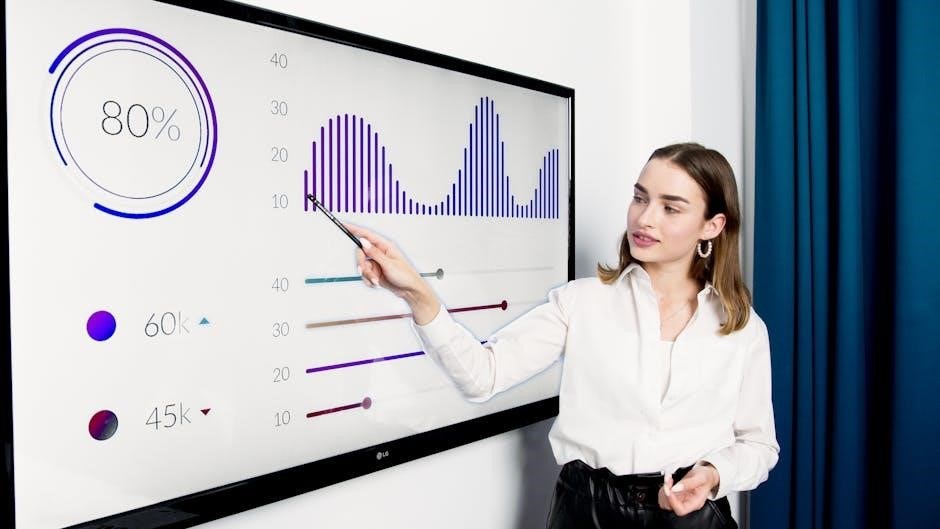pdf psychrometric chart
- by antonina

Okay, here is the requested content:

PDF Psychrometric Chart: An Overview
A psychrometric chart is a graphical representation of the thermodynamic properties of moist air. In PDF format, it offers accessibility and portability for HVAC professionals. It is used to determine air properties and analyze air conditioning processes.
Okay, here is the requested content:
Definition and Purpose of a Psychrometric Chart
A psychrometric chart is a graphical tool representing the thermodynamic properties of moist air, including dry bulb temperature, wet bulb temperature, humidity ratio, and enthalpy. Its primary purpose is to facilitate the analysis and design of air conditioning processes, such as heating, cooling, humidification, and dehumidification. By plotting air conditions on the chart, engineers can determine various air properties and evaluate the effects of different processes on air’s state. The chart is invaluable for understanding environmental problems, predicting moisture condensation, and optimizing HVAC system performance, ensuring comfortable and energy-efficient indoor environments. It serves as a crucial resource for professionals in HVAC, meteorology, and industrial processes.
Okay, here is the requested content:
Key Components of a Psychrometric Chart
A psychrometric chart includes several key components: dry bulb temperature lines, humidity ratio lines, relative humidity curves, enthalpy lines, and wet bulb temperature lines. Each component represents a different property of moist air.
Okay, here is the requested content:
Dry Bulb Temperature Lines
Dry bulb temperature lines are vertical lines on a psychrometric chart that represent the air’s temperature as measured by a standard thermometer. These lines are uniformly spaced and run parallel to each other, spanning the horizontal axis of the chart. Dry bulb temperature is a fundamental property used in conjunction with other parameters to determine the overall state of moist air. When locating a specific point on the chart, the dry bulb temperature is one of the primary coordinates to consider. It is essential for HVAC design and analysis, allowing engineers to assess and control thermal comfort.
Okay, here is the requested content:
Humidity Ratio (Specific Humidity) Lines
Humidity ratio lines, also known as specific humidity lines, are horizontal lines on a psychrometric chart indicating the mass of water vapor per unit mass of dry air. These lines run parallel to the x-axis, typically expressed in pounds of water per pound of dry air (lb/lb) or kilograms of water per kilogram of dry air (kg/kg). As you move upwards on the chart, the humidity ratio increases, signifying a higher moisture content in the air. Specific humidity is vital for understanding the absolute amount of moisture present, independent of temperature. It aids in calculating moisture-related loads in HVAC systems.
Okay, here is the requested content:
Relative Humidity Curves
Relative humidity curves on a psychrometric chart represent the percentage of moisture air holds relative to its maximum capacity at a given temperature. These curves are typically displayed as curved lines, with the 100% curve representing saturation, also known as the dew point line. Lower percentages indicate drier air, while higher percentages suggest more humid conditions. Relative humidity is temperature-dependent; therefore, cooling air increases its relative humidity, potentially leading to condensation. These curves are essential for assessing comfort levels and predicting condensation risks in various applications, including HVAC design and weather analysis; They help determine how close air is to saturation.
Okay, here is the requested content:
Enthalpy Lines
Enthalpy lines on a psychrometric chart represent the total heat content of moist air, encompassing both sensible and latent heat. These lines are usually diagonal, sloping downwards from left to right. Enthalpy is measured in BTU per pound of dry air (IP units) or kJ per kilogram (SI units). Following an enthalpy line allows you to determine changes in heat content during processes like heating, cooling, humidification, or dehumidification. They are useful in HVAC design for calculating energy requirements for air conditioning systems. Intersecting an enthalpy line with other properties allows for a complete understanding of the air’s thermodynamic state. Understanding enthalpy is vital for efficient system design.
Okay, here is the requested content:
Wet Bulb Temperature Lines
Wet bulb temperature lines on a psychrometric chart indicate the temperature a parcel of air would have if cooled to saturation by evaporating water into it, with the heat supplied by the air. They are diagonal lines, sloping downwards from left to right, but are steeper than enthalpy lines. The wet-bulb temperature reflects both temperature and humidity. The wet bulb temperature can be measured using a thermometer with a wet wick exposed to air flow. These lines are essential for determining cooling potential through evaporative cooling processes. They intersect other lines to define air conditions. They are crucial in diverse applications.
Okay, here is the requested content:

Using a PDF Psychrometric Chart
Using a PDF psychrometric chart involves locating known air properties and finding their intersection on the chart. This intersection reveals other properties like humidity ratio, enthalpy, and dew point temperature. Accurate readings require careful attention to the chart’s scale.
Okay, here is the requested content:
Determining Air Properties
To determine air properties using a PDF psychrometric chart, identify at least two known values, such as dry-bulb temperature and relative humidity. Locate these values on their respective axes or curves on the chart. Find the point where the lines corresponding to these values intersect. This intersection point represents the state of the air. From this point, you can read off other air properties, including humidity ratio, enthalpy, dew point temperature, and wet-bulb temperature. Ensure accurate readings by carefully following the lines and scales on the chart. The chart provides an efficient method for understanding moist air.
Okay, here is the requested content:

Types of PDF Psychrometric Charts
PDF psychrometric charts come in various types, including normal temperature, high-temperature, and sea-level versus altitude charts. Each type is designed for specific applications and environmental conditions, ensuring accurate analysis of air properties.
Okay, here is the requested content:
Normal Temperature Charts
Normal temperature psychrometric charts are designed for typical HVAC applications where temperatures range within a standard comfort zone. These charts are commonly used for analyzing air conditioning processes in residential, commercial, and institutional buildings. They provide data on dry bulb temperature, wet bulb temperature, humidity ratio, relative humidity, enthalpy, and specific volume. Normal temperature charts are essential for designing and optimizing HVAC systems to maintain comfortable indoor environments. These charts are available in both Imperial and SI units, catering to different engineering standards and preferences. Accurate readings are essential to ensure effective and safe HVAC design.
Okay, here is the requested content:
High-Temperature Charts
High-temperature psychrometric charts are specifically designed for applications involving elevated temperatures, exceeding those typically found in standard HVAC systems. These charts are crucial in industrial processes like drying, baking, and waste heat recovery. They extend the temperature range of the psychrometric chart to accommodate extreme conditions. High-temperature charts enable engineers to analyze air properties and design systems that operate efficiently at high temperatures. These charts are invaluable in industries where precise control of humidity and temperature is critical for process optimization. Such processes are crucial in industries where precise control of humidity and temperature is critical for process optimization and efficiency.
Okay, here is the requested content:
Sea Level vs. Altitude Charts
Psychrometric charts are influenced by barometric pressure, which varies with altitude. Sea level charts are based on standard atmospheric pressure at sea level. Altitude charts account for reduced pressure at higher elevations. Using a sea level chart at altitude leads to inaccurate readings. Altitude-specific charts are essential for accurate analysis in mountain regions or elevated industrial sites. These charts correct for changes in air density and humidity. They ensure precise calculations in HVAC design, weather analysis, and industrial processes. Accurate psychrometric data is crucial for optimal performance and energy efficiency. Therefore, selecting the appropriate chart based on altitude is a critical step.
Okay, here is the requested content:
Applications of Psychrometric Charts
Psychrometric charts find extensive use in diverse fields, including HVAC design for buildings, weather prediction analysis for meteorological studies, and various industrial process optimization to ensure effective drying and humidification processes.
Okay, here is the requested content:
HVAC Design and Analysis
In HVAC (Heating, Ventilation, and Air Conditioning) design and analysis, psychrometric charts are indispensable tools. They allow engineers to visualize and analyze air conditioning processes such as heating, cooling, humidification, and dehumidification. By plotting the state of air on the chart, engineers can determine the required energy input or output for each process. This enables precise calculations of heating and cooling loads, selection of appropriate equipment, and optimization of system performance. Furthermore, psychrometric charts aid in diagnosing problems related to indoor air quality and energy efficiency, ensuring comfortable and healthy indoor environments while minimizing energy consumption in buildings.
Okay, here is the requested content:
Weather Prediction and Analysis
Psychrometric charts, while primarily used in HVAC, also find applications in weather prediction and analysis, albeit to a lesser extent. Meteorologists can utilize psychrometric principles to understand atmospheric moisture content and its impact on weather phenomena. By analyzing air temperature, humidity, and pressure, they can assess the potential for cloud formation, precipitation, and fog development. However, dedicated meteorological models and tools are typically preferred for comprehensive weather forecasting. Psychrometric charts offer a simplified view of atmospheric conditions, useful for educational purposes or quick assessments of localized weather patterns. They help visualize the relationship between temperature and humidity in the atmosphere.
Okay, here is the requested content:
Industrial Processes
Psychrometric charts play a vital role in various industrial processes where controlling air conditions is crucial. Industries such as food processing, pharmaceuticals, and manufacturing rely on precise humidity and temperature control for product quality and process efficiency. For instance, in drying processes, psychrometric charts help determine the optimal air conditions for removing moisture from materials effectively. They aid in analyzing the energy requirements for heating or cooling air streams, ensuring efficient operation of industrial equipment. Moreover, the charts are useful in designing and optimizing air handling systems for specific industrial environments, maintaining consistent product quality, and minimizing energy consumption.
Okay, here is the requested content:

Free PDF Psychrometric Chart Downloads
Accessing psychrometric charts in PDF format is incredibly convenient for professionals and students alike. Several online resources offer free downloads of these charts, catering to various needs and applications. Websites of engineering societies, HVAC equipment manufacturers, and educational institutions often provide downloadable PDF charts. These charts may be available in different unit systems (SI or IP) and for various altitude ranges, ensuring users can select the most appropriate chart for their specific calculations. Always verify the source and version of the chart to ensure accuracy and reliability. These resources empower users with essential tools for psychrometric analysis.
Related posts:
Dive deep into air properties with our easy-to-use PDF psychrometric chart! Download yours now and master humidity, temperature, and more. It’s free!
Posted in PDF